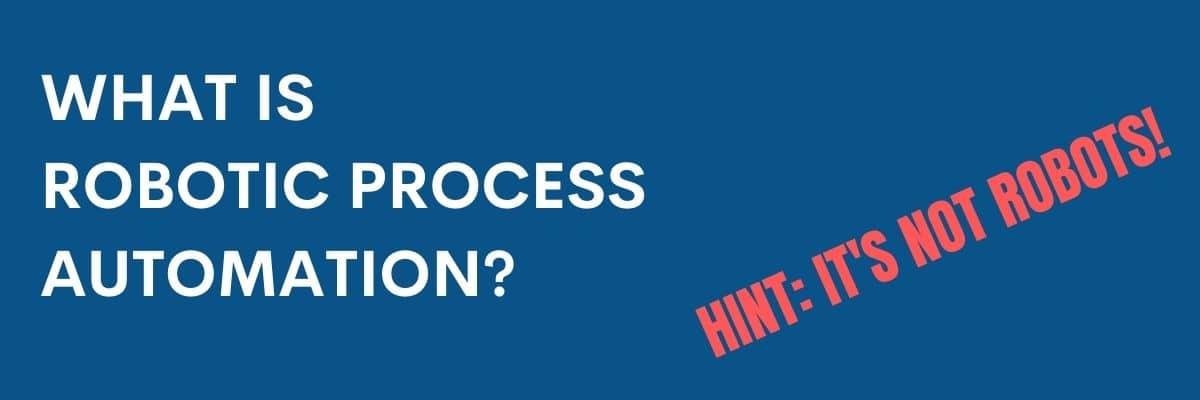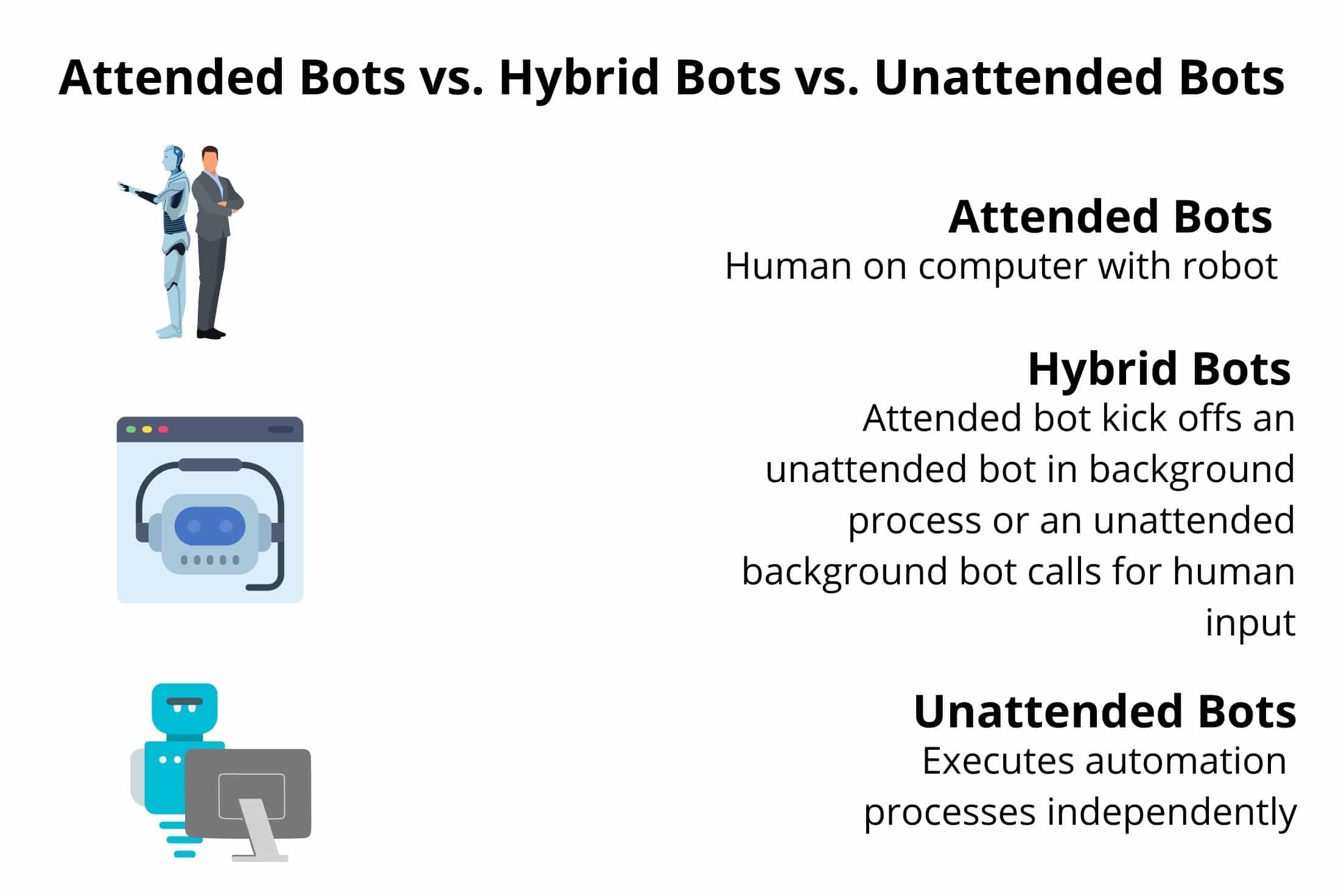
This year Robotic Process Automation (RPA) software is expected to hit $1.89 billion, according to Gartner. Many companies are finding RPA a necessity to digitization in a post-COVID world and to keep up with demand for better customer experiences. If you’re trying to learn what Robotic Process Automation is and how it can be applied to your industry, you’ve come to the right place.
What is Robotic Process Automation?
Robotic Process Automation is software that uses rpa bots to automate basic “structured” tasks, that requires manual, repetitive work. RPA bots are different from the physical robots you might think of in car factories.
Software Robots —
Performs Computer Tasks
– Logging into different systems
– Extracting data from documents
– Validating data
Physical Robots —
Performs Physical Tasks
-Welding at a car factory
– Picking up items in a warehouse
– Scanning items to make sure they meet a standard
A Brief History of RPA
The seed of RPA was first planted with the concept of screen scraping, which was developed just before the birth of the internet. Screen scraping is collecting data that is contained within a computer program to plug it into another. When the internet was born, screen scraping evolved its functionality to apply to websites to take and plug in data.
Another development in technology that helped set the foundation of RPA is workflow management software which is used to reduce human tasks by automating actions.
With the advancement of artificial intelligence and machine learning, which uses human intelligence and data to understand outcomes, RPA was born. AI and Machine Learning contributed to RPA by broadening its processes through image recognition, language processing and even decision making.
The first actual market offering of RPA came in the early 2000s.
How Does Robotic Process Automation Work?
Every RPA tool is a software platform that hosts software bots. Within the software you can assign different commands to take place, be it an application on your computer, your browser or your email. To use RPA, you would go to the software, available via the web, and log in with your credentials.
The platform will have a bot-building capability with different options broken down into categories from coding to specific software such as Excel automation.
RPA bots are divided into three different categories: Attended, Hybrid and Fully Unattended.
Attended Bots: Attended bots are exactly what they sound like! They are attended by a human to help complete tasks. Attended bots will be trigged by the human worker to start tasks. One example of this is where a human worker types in customer information and the bot will do a search within a CRM system.
Hybrid Bots: Hybrid bots take qualities of both an attended and unattended bot to complete a task. A specific example might be that an unattended bot starts off a process of a task and then might run into a step of the process that requires human decision. Here is where the attended bot will come into play as the human makes the decision and then continues to automate the process. This can also go the other way around where the human worker triggers an attended bot, which will later trigger an unattended bot to complete a task.
Some examples of where a hybrid bot might come into play is an unattended chatbot that is unable to help a customer then escalates to a human or a salesperson using an attended bot that completes an order process, which triggers an unattended bot to identify upsell and cross–sell opportunities to the customer.
Unattended Bots: Unattended bots are bots that work by themselves and require no humans. Oftentimes, these bots will be designated to machines, known as virtual machines, to complete tasks and use rules-based decision-making set up by the developer. An example of a task an unattended bot would do is complete end-to-end invoice processing.

What are the Benefits of Robotic Process Automation
Cost Savings
Robotic process automation delivers substantial cost savings. For one, having an RPA virtual bot speed up human tasks means less labor costs over time. In other ways, RPA’s acceleration of processes means human workers can focus on high-value tasks.
Fewer Errors
Since RPA extracts data straight from the source, there is no chance of there being errors, as compared to a human worker that enters it.
Improved Customer Satisfaction
When you automate your processes, work tasks get done faster, which carries over to the customer for quicker turnaround time.
Extends Legacy Infrastructure
RPA is non-intrusive and easy to implement within legacy systems, prolonging their use and investment.
Where is RPA Used?
Globally, RPA has many advantages for every kind of industry and for every department — and the use cases seem boundless. As you read this, there is probably a new way RPA is being used right now, unlike anything ever before. Below are common examples RPA is used.
RPA Use Cases in Insurance
- Claims Processing
- Underwriting
- Data Validation
- Policy Issuance
- Payment Processing
- Fraud Detection
- Risk Assessment
- Policy Renewals and Cancellations
- Policyholder Billing
RPA Use Cases in Banking
- Account Openings and Closures
- Loan Processing and Validation
- Know Your Customer (KYC) Compliance
- Mortgage Lending
- AML Screening
- Customer Updates
- Debit and Credit Card Management
- Transfers
- Regulatory Monitoring
- Report Automation
- Customer Verification
RPA Use Cases in Health Systems
- Patient Appointment Scheduling
- Medical Billing
- Settlements
- Provider Application
- Patient Discharge
- Patient Registration
- Claims Management
- Billing Cycles
- Auditing
- Regulatory Compliance
RPA Use Cases in Manufacturing
- Customer Support
- Purchase Order Processing
- ERP Automation
- Reporting
- Data Migration
- Logistics Automation
- Predictive Maintenace
- Progress Tracking
- Order Fulfillments
- Bill of Materials
RPA Use Cases in HR
- Employee Onboarding
- Attendance Tracking
- Resume Screening
- Expense Management
- Payroll Management
- Offer Letter Administration
- Background Verification
- Interview Scheduling
- Timesheet Management
- Benefits Management
RPA Use Cases in IT
- Server Management and Monitoring
- User Management
- Incident Management
- Software Installations
- Password Resets
- Backup and Restoration
- Batch Processing
- Hardware and Software Requests
- Virus Checks
- Event Logging
RPA Use Cases in Finance and Accounting
- Vendor Onboarding
- Funds Transferring
- Accounts Payable and Receiving Processing
- Investment Management
- Financial Forecasting
- Travel and Expense Management
- Tax Reporting
- Pricing Comparisons
- Vendor Invoicing
- Payment Tracking
RPA Use Cases in Supply Chain
- Inventory Management
- Work–Order Management
- Order Processing
- Shipment Scheduling and Tracking
- Freight Management
- Supply and Demand Planning
- Returns and Refund Processing
- Sales Order Creation
- Supplier Reports and Analysis
- Historical Sales Data Reports
When to Use Robotic Process Automation
Is RPA right for you? If you’re a business that has the following traits, RPA is a high-value investment.
6 Factors to Consider for RPA
1. You have a lot of high-volume tasks.
If you find that part of your business involves a ton of recurring tasks that happen daily or weekly, RPA is ideal to step in and take over.
2. You carry out many repetitive tasks, especially with structured data.
If you have employees that do the same task over and over, give them the freedom to take back their workday to focus on more important tasks. RPA can step in to do repetitive tasks.
3. You do a ton of data entry.
Let’s face it, not many things are as tedious as doing manual data entry. This is a great application where RPA can fill in to extract data and plug it into any software or system.
4. You deal with multiple legacy systems with “swivel-chair” management.
Are your employees constantly having to deal with multiple systems back and forth? RPA can be directly integrated into these systems to unify swivel-chair tasks into one system.
5. You need to keep up with compliance and regulations.
If compliance and regulations are making your head spinfrom trying to keep up, RPA can automate this process. RPA is able to automatically check with the latest compliance and regulations updates with the trigger to notify you of any changes.
6. You have trouble with efficiently delivering services.
Whether you have barriers with delivering quick turnarounds in customer service or handling internal employee processes, RPA can help deliver by automating processes quicker than ever. Customer and employee onboarding, for example, is ideal for this as RPA can extract the information and put it into the system faster than a human.
How to Implement Robotic Process Automation
Robotic Process Automation is available through different vendors and business partners. It’s recommended to do an in-depth analysis to see which RPA platform is appropriate for your industry.
At Pyramid Solutions, we can offer you a free in-depth analysis. We partner with industry-leading RPA vendors including, Automation Anywhere and IBM RPA. We’re able to take any questions you have about RPA and provide a free demo to help you understand the different platforms available. We can even implement your RPA solution for you and get you up to speed on what you need to know.
